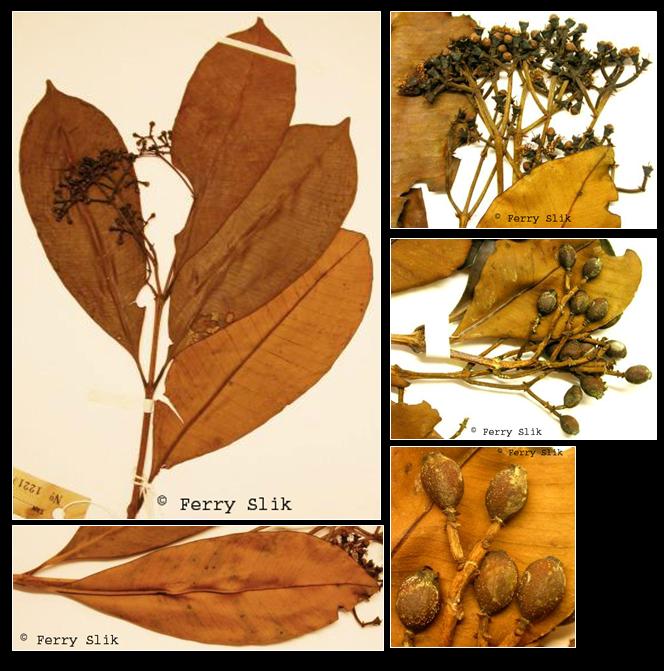Syzygium fastigiatum (Blume) Merr. & Perry, Mem. Amer. Ac. 18 (1939)
Latin for 'bunched like a bundle of twigs', referring to the form of the inflorescences.Synonyms
Acmena bracteolata (Wight) Walp.
Calyptranthus fastigiata Blume
Calyptranthus floribunda Blume
Caryophyllus fastigiatus (Blume) Blume
Caryophyllus floribundus (Blume) Blume ex DC
Chytraculia fastigiata Kuntze
Eugenia bibracteatum Greves
Eugenia bracteolata Wight
Eugenia chloroleuca Ridl.
Eugenia confertiflora Koord. & Valet.
Eugenia elmeri Merr.
Eugenia fastigiata (Blume) Koord. & Valet.
Eugenia sablanensis Elmer
Syzygium bibracteatum (Greves) Merr. & Perry
Syzygium bracteolatum (Wight) Masamune
Syzygium confertiflorum (Koord. & Valet.) Masamune
Syzygium elmeri (Merr.) Masamune
Diagnostics
Sub-canopy tree up to 28 m tall and 43(-70) cm dbh. Stipules absent. Leaves
opposite, simple, penni-veined with secondary veins close together, venation
inconspicuous, glabrous. Flowers ca. 5 mm diameter, white-yellow, protruding
stamens, flowers in panicles. Fruits ca. 9 mm long, yellow-red-brown, fleshy
berries.
Description
Main canopy tree to 28 m tall, 70 cm diameter; bark pale buff to grey-brown, smooth or papery
flaky, inner bark pale red-brown. Parts hairless. Twig c.2 mm diameter apically, round-compressed,
bluntly quadrangular or with 4 slender but distinct sometimes twisted ribs, yellowish brown,
usually smooth. Leaf blade c.12 x 5.5(6-15 x 3-6) cm, narrowly obovate, thinly leathery, wrinkling
on drying and dull pale greenish tawny above, pale yellow-brown beneath; base wedge-shaped,
tapering into c.11 mm stalk, apex rounded to shortly bluntly acuminate, densely pitted above,
obscurely or more prominently (juveniles) pimpled beneath; veins subequal, c.25 pairs, visible but
hardly raised though more so beneath than above and drying darker than the blade, minutely furrowed
above, spreading; tertiaries visible beneath, obscure above; intramarginal vein 1, hugging margin,
hardly looped. Panicle to 3-terminal or 1-subterminal axillary, to 10 cm long but very variable,
slender, ascending, to 3-branched with to 3 x 2 mm prominent subpersistent triangular clawed bracts.
Flower bud to 7 x 3 mm, narrowly obovoid tapering from apex to base with indistinct pseudostalk,
broadening towards apex, with short broadly triangular erect sepal lobes, with 2 prominent cupped
persistent bracteoles; style extending c.4 mm, the many stamens to 8 mm. Fruit c.10 x 5 mm, obovoid,
pale yellow-green, slightly tapering to a shortly toothed calyx rim. [from Tree Flora of Sabah and
Sarawak]
Ecology
In undisturbed to slightly disturbed (open) mixed dipterocarp, keranga,
coastal, mangrove and sub-montane forests up to 1500(-2100) m altitude. Common on
alluvial sites near or along rivers, streams and mangrove swamps, but also
common on hillsides and ridges. Often on sandy to ultrabasic soils.
Distribution
Indo-China, Burma, Thailand, Peninsular Malaysia, Sumatra, Java, Borneo.
Local names
Borneo: Obah, Onsabundo, Tunjang, Ubah.
